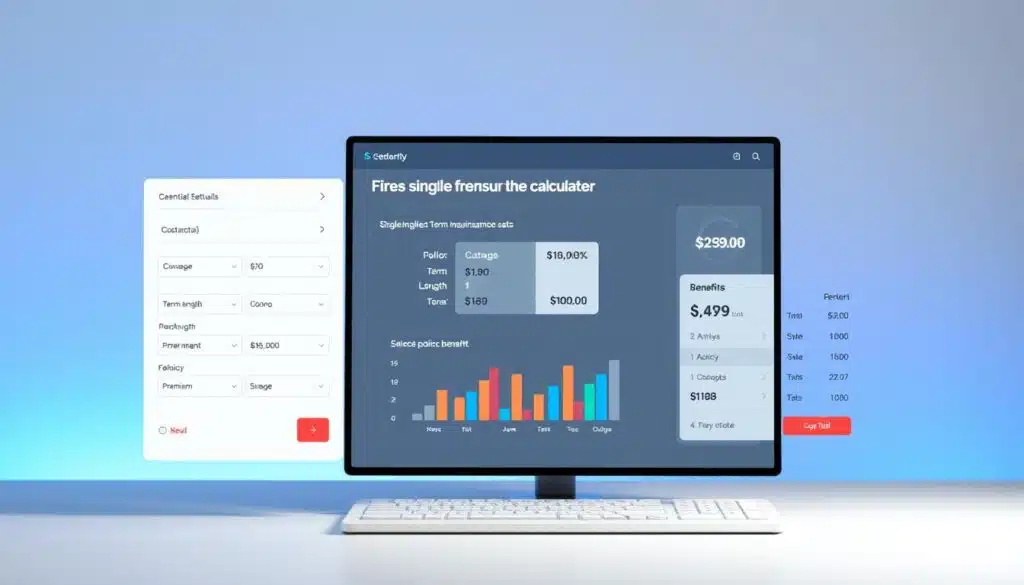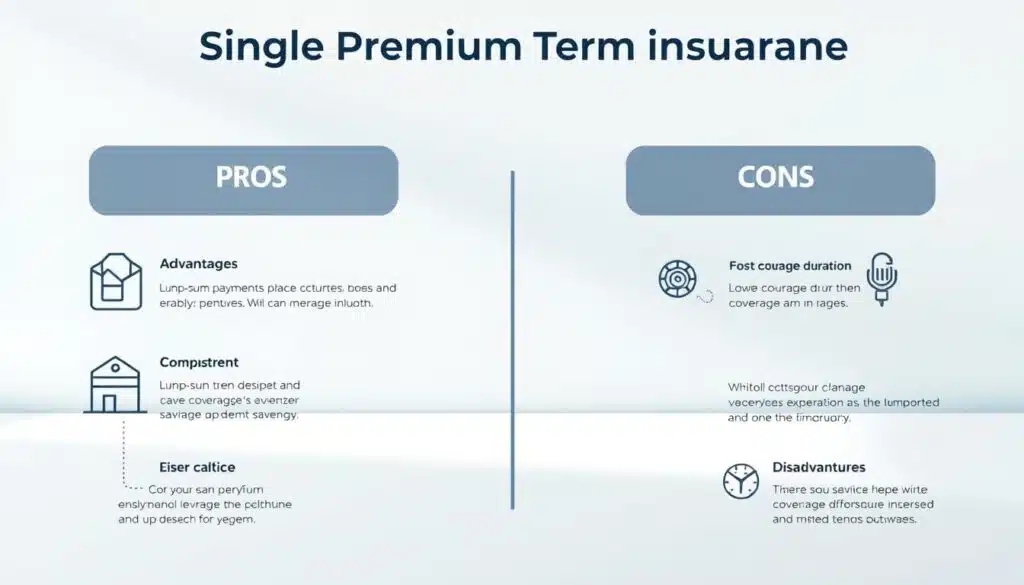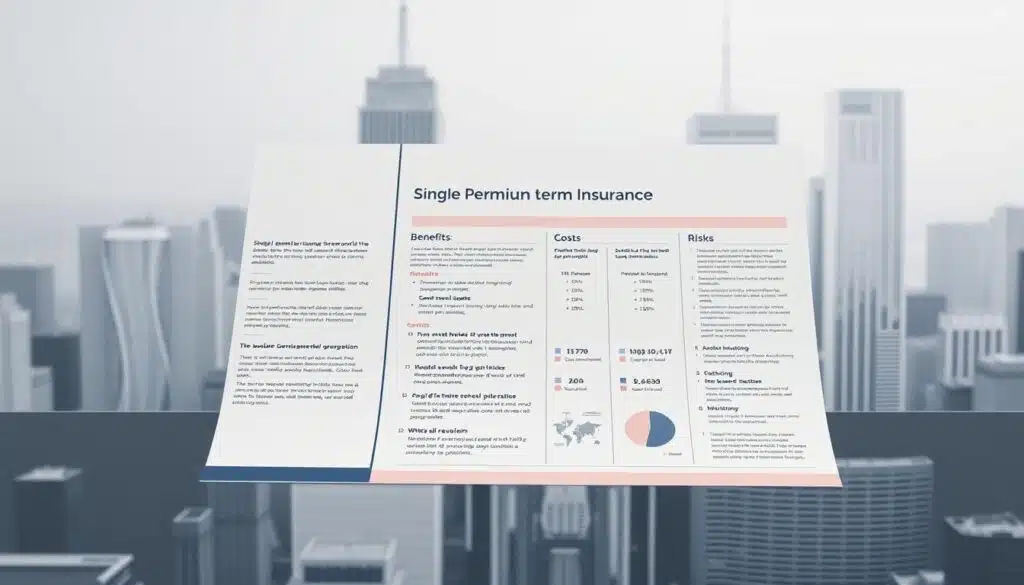Single premium term insurance means you pay once for a death benefit. It’s great for those who like simple plans and don’t want to worry about payments. It’s perfect for savers, retirees, and busy people who prefer a single payment over ongoing costs.
Before buying, use a single premium term insurance calculator. It shows how a single payment compares to regular payments. People often look for the best single premium term insurance. This article helps you understand the costs, coverage, and tax implications.
Table of Contents
ToggleKey Notes;
- Single premium term insurance funds coverage with a single payment, eliminating future premiums.
- A calculator helps estimate cost and compare single payment life insurance to periodic premiums.
- Immediate coverage and budgeting simplicity rank among the main advantages.
- Large one-time cost and unique tax rules form the primary disadvantages.
- Compare quotes from established carriers and review pros and cons before committing.
What Is Single Premium Term Insurance and How It Differs from Other Policies
Single premium term insurance means you pay once for coverage that lasts a set time. You pick how much coverage you want and pay for it all upfront. This way, you get death benefit protection right away without worrying about future payments.
Definition and core mechanics of single premium policies
A single premium policy is paid for once. This payment secures the death benefit for a set time. In some cases, the payment also starts building cash value at a certain rate.
How single premium term insurance differs from traditional term life insurance
Traditional term life insurance needs regular payments, like monthly or yearly. If you miss a payment, your coverage can end. Single premium term insurance avoids this by paying for everything upfront. This means you pay more at first but don’t have to worry about payments later.
Differences compared with single premium whole life and universal life
Single premium whole life insurance grows your cash value at a set rate and offers a fixed death benefit. Universal life insurance’s cash value grows based on the insurer’s interest rate, sometimes with a minimum guarantee. Variable life insurance puts your cash value into investments, which can be risky.
| Feature | Single Premium Term | Single-Premium Whole Life | Single-Premium Universal/Variable |
|---|---|---|---|
| Premium Structure | One lump sum for term coverage | One lump sum funds permanent coverage | One lump sum funds permanent coverage with interest or market exposure |
| Cash Value | Minimal or none during term | Contractual guaranteed accumulation | Interest-sensitive or market-dependent growth |
| Death Benefit | Guaranteed for specified term | Guaranteed for life | Guaranteed with possible variability tied to account performance |
| Tax/Treaty Concerns | Lower MEC risk due to lack of cash value; consult tax advisor | High likelihood of MEC classification unless structured carefully | High MEC risk; investment features affect tax treatment |
| Best Use Case | Temporary coverage without future premiums | Long-term wealth transfer and guaranteed growth | Investing inside a policy with active risk tolerance |
Single Premium Term Insurance: Coverage Duration, Death Benefit, and Policy Structure
Single premium term insurance is simple. You pay once and get coverage for a set time. It’s like other term insurance, with options for 10, 15, 20, 25, or 30 years. What’s available depends on the insurance company.
Typical coverage lengths available in single premium options
Most insurance companies offer the same term lengths as annual policies. You can usually find 10-year and 20-year options. Some offer 25- or 30-year terms, and some special products might have shorter terms.
What you can buy depends on your age, health, and how much you want to cover. Insurance companies set limits on how much you can buy with a single payment.
How the death benefit is determined and guaranteed
The death benefit is the face amount you choose when you buy the policy. Your age, health, and smoking habits affect how much you pay upfront. The insurance company promises to pay out when you die, as long as you’re covered and premiums are paid.
Policy riders, exclusions, and claim triggers
Riders can add extra features to your policy. You might get riders for accelerated death benefits or to switch to permanent coverage. Some policies have riders for critical illness or long-term care, but these are less common.
Policy exclusions and claim rules are clear in the policy terms. Common exclusions include suicide early on, fraud, and lying on your application. To get a payout, you must die during the policy term and have a valid claim from a beneficiary.
Single premium term insurance doesn’t build cash value like permanent policies. This makes premiums lower for big face amounts over fixed times. Always check the guarantee, exclusions, and riders before you buy.
Cost Breakdown and Pricing Factors for Single Premium Term Insurance
Understanding the cost of single premium term insurance starts with basic pieces insurers use to set a price. Age at purchase, health status, smoking behavior, and the face amount form the core inputs. Actuarial tables, gender, family medical history, chosen term length, and company expense loadings shape final quotes.
Pricing factors include underwriting tiers from carriers such as Prudential or New York Life, plus claims history and product-specific charges. Administrative fees and reserve requirements add to the single premium policy pricing. Insurers may apply minimum single-premium thresholds for operational efficiency.
Compare a one-time payment to periodic premiums by calculating present value. Use a realistic discount rate, for example 3%–5%, to convert 20 years of annual premiums into a lump-sum equivalent. This method clarifies whether a single payment life insurance example makes sense for your capital and goals.
Single payment offers benefit of no future premium risk. Buyers give up liquidity and trade a large upfront outlay for premium insurance certainty. Over time, a lump-sum can end up cheaper or pricier than cumulative periodic premiums depending on interest rates and mortality credits.
Below is a compact scenario framework to test single premium policy pricing against annual premiums. Adjust inputs to match your carrier quote and use insurer illustrations for precise numbers.
| Scenario | Age | Face Amount | Term | Assumed Discount Rate | Notes |
|---|---|---|---|---|---|
| Baseline quote | 45 | $500,000 | 20 years | 4% | Compare PV of 20 annual premiums to single premium quote from carrier |
| Smoker adjustment | 45 | $500,000 | 20 years | 4% | Higher mortality load increases single premium significantly |
| Shorter term | 45 | $500,000 | 10 years | 3.5% | Lower duration reduces reserve needs and single premium |
Use this practice: request carrier illustrations, compare present-value conversions, and ask for scenario tables. Real quotes from State Farm, MassMutual, or Lincoln Financial show how pricing factors translate into a single premium dollar figure.
When you run a single payment life insurance example, include loadings, mortality reserve, and administrative fees. This produces a realistic estimate of how the cost of single premium term insurance stacks up versus paying premiums over time.
Single Premium Term Insurance Calculator and Cost Estimation Tools

A single premium term insurance calculator turns a big idea into real numbers. These tools help you figure out how much coverage you need. They let you compare policies and plan your budget.
How to use a calculator
Start by entering your basic info: age, gender, and if you smoke. Then, add how much coverage you want and for how long. Choose when you want the policy to start.
Some calculators show how much a lump sum buys in coverage. Others compare it to regular payments.
Recommended inputs and assumptions
Be honest about your health and the right underwriting class. Pick the exact coverage and term you need. Don’t forget to add riders like disability benefits.
Use a 3%–5% discount rate for after-tax comparisons.
What to check in the output
- Check if the tool uses your underwriting class.
- See if it shows lump-sum or regular premium values.
- Look for surrender charges or cash-value projections.
Comparison to whole life and top tools
A single premium whole life calculator focuses on cash-value growth. It shows surrender schedules and long-term guarantees. It also warns about Modified Endowment Contracts and tax effects.
Use insurer illustrations for accurate numbers. Tools from Fidelity and independent brokers often show MEC outcomes.
Choosing the best tools
Find the best single premium life insurance calculator. Look for clear assumptions and fee breakdowns. Compare different tools to find the most accurate ones.
Practical next steps
- Run at least two different single premium term insurance calculator outputs.
- Request full insurer illustrations for any quotes you consider binding.
- Speak with a licensed agent or fee-only financial planner to confirm assumptions and tax treatment.
Who Should Consider Single Premium Term Insurance: Use Cases and Suitability
Single premium options are good for many situations. They offer immediate protection with a single payment. This section explains who finds this useful and what to consider.
Young professionals — when a lump-sum approach makes sense
Young professionals might pick single premium after getting a big bonus or inheritance. It’s a way to get coverage now and avoid future price increases.
Think about the value of paying all at once versus monthly or yearly. For many, monthly plans are cheaper. Use single premium only if it won’t hurt your savings.
Families — replacing income and covering debts with a single payment
Families can buy term insurance with a single payment. This ensures debts are paid or income is replaced without worrying about premiums. It’s good for times when income is not steady.
Consider if you can afford to use all your money for insurance. Make sure the coverage matches your debts or income needs exactly.
Seniors — single premium term insurance for seniors: pros, cons, and special considerations
Seniors can get short-term protection of 10 to 20 years without paying premiums again. This is useful for estate cleanup or temporary income needs.
But, it costs more upfront and might not be available for everyone. Compare it to other options before deciding. Term policies don’t build cash value, but permanent options might have tax effects.
Use this checklist to gauge suitability:
- Large liquid funds available without harming emergency reserves
- Clear purpose for coverage such as debt payoff, mortgage protection, or short-term income replacement
- Tolerance for tying up capital instead of using other cash alternatives
- Preference for administrative simplicity and elimination of future premium billing
| Buyer Profile | Primary Benefit | Key Caution |
|---|---|---|
| Young professionals | Lock low rates now, avoid future payments | Often less cost-effective than periodic premiums |
| Families | Immediate, guaranteed coverage for dependents | Reduces household liquidity and emergency cushion |
| Seniors | No lapse risk, short-term protection without bills | High lump-sum cost and limited availability |
| All buyers | Administrative simplicity and single payment clarity | Opportunity cost of capital; compare to other single premium options |
Pros and Cons of Single Premium Term Insurance

Single premium term insurance is a one-time payment for coverage. It’s great for those who want quick protection and simple payments. Here’s a breakdown of the good and bad sides to help you choose wisely.
Advantages
It starts covering you right away after the payment. This is a big plus for those needing to protect a mortgage or tuition. It gives peace of mind fast.
It also means no more worrying about future payments. This makes managing your finances easier and reduces the risk of forgetting to pay.
Many find it simple to pay once and be done. It’s easier to plan your money compared to paying every month for years.
Disadvantages
The biggest drawback is the high upfront cost. Many people can’t afford it without using up their savings or emergency funds.
Not all insurance companies offer this option. You might find limited choices in terms of how much coverage you can get or for how long.
Using that money elsewhere could earn more. You should think about whether the insurance is worth the cost compared to other investments.
Comparison with Permanent Single-Premium Options
Single premium whole life builds cash value over time. This can help with estate planning and protecting against creditors.
But, these policies can have higher fees and taxes. This is different from term insurance, which is simpler and cheaper.
Term insurance is best for short-term needs. It’s a good choice if you don’t need cash value and want a lower-cost option.
Practical guidance
Go for term if you need coverage for a set time and don’t want ongoing payments. Consider single premium whole life if you want permanent coverage and cash value growth, even with higher costs.
Talk to a licensed advisor from Prudential, MassMutual, or New York Life. They can help you compare and understand the costs before you decide.
Tax Implications and Modified Endowment Contract (MEC) Rules
Single premium funding can change how the IRS treats a policy. This short primer explains why a large upfront payment often leads to Modified Endowment Contract status. It also talks about what that means for taxes, withdrawals, and estate planning.
Why single premium funding often triggers MEC classification
The seven-pay test under IRC Section 7702A sets a limit on how much premium a permanent policy may accept in the first seven years. A single lump-sum payment almost always exceeds that limit. When that happens, the policy becomes a Modified Endowment Contract from day one.
Tax consequences for withdrawals, loans, and early access before age 59½
MEC rules change distribution ordering to LIFO, meaning gains leave the policy before basis. Withdrawals or loans that tap cash value can generate ordinary income on the gain. If the owner takes taxable amounts before age 59½, a 10% penalty may apply, similar to penalty rules for retirement accounts.
Loan treatment differs from standard life insurance rules. Loans that reduce policy basis or produce taxable gain may trigger immediate income tax. Death benefits generally remain income tax-free to beneficiaries under IRC life insurance rules despite MEC status.
How tax treatment differs between term and permanent single-premium policies
Term policies normally lack meaningful cash value, so MEC rules do not apply. The death benefit in a pure term contract remains a straightforward, tax-free payout if the insured dies during the term.
Permanent single-premium contracts, including whole life and universal designs, usually fail the seven-pay test and become MECs. This shifts tax treatment for lifetime distributions and reduces flexibility for tax-advantaged withdrawals.
Practical comparisons and tools
Use a single premium whole life insurance calculator tax module to test scenarios before purchase. Compare results with single premium term insurance tax outcomes to see differences in liquidity, cost, and tax ordering.
Actionable next steps
- Run numbers with a single premium whole life insurance calculator tax feature when considering permanent funding.
- Check single premium term insurance tax implications if you want death benefit simplicity without cash value complexity.
- Talk to a CPA or fee-only financial planner before funding a one-time premium to confirm compliance with MEC rules and tax strategy.
Risks, Surrender Charges, and Policy Replacement Considerations

Buying a single premium term contract is more than just looking at the price. It locks up your money and changes your financial flexibility. Think about how this affects your money before you buy.
Liquidity risk is big when you put a lot of money into a life contract. You might need that money for emergencies or new business ideas. Make sure you have cash set aside outside the policy.
Policy loan rules, when you can cancel, and conversion options matter. Some contracts have high fees early on. These fees can eat into your money and lower the death benefit if you cancel too soon.
Surrender charges usually go down over time. But canceling early can lead to penalties. These penalties vary by company and policy. Always check the contract for exact details.
Ending a policy can lead to taxes in some cases. If it’s a special type of contract, taking money out or getting a loan can trigger taxes. Loans that aren’t paid back can also reduce the death benefit and affect your beneficiaries.
Replacing a policy needs careful planning. Switching policies can start new waiting periods for certain clauses. New underwriting might raise your rates or even deny you coverage. Replacing policies can also mean losing money in the old contract.
Ask for illustrations before switching policies. Compare the cash value, future premiums, and death benefits. Plan carefully to avoid gaps in coverage or taxes.
Think about other options if the risks of single premium term insurance are too high. Consider buying term insurance with regular payments, investing the money, or buying a permanent policy slowly. These options might be better for you.
Do scenario tests to see how much money you’ll keep, how much you might earn, and how much coverage you need. Talk to a licensed agent and a tax advisor to understand all the costs, including surrender charges and penalties.
| Issue | Impact | What to check |
|---|---|---|
| Liquidity risk single premium | Ties up capital; limited quick access | Emergency reserves outside policy; loan and withdrawal rules |
| surrender charges | Loss of principal on early cancellation | Surrender schedule, percentage by year, net surrender value |
| single premium policy penalties | Taxable events on MECs; penalties for early access | MEC status check, tax consequences, withdrawal order |
| policy replacement | New contestability, possible higher rates, lost cash value | In-force illustrations, timing, underwriting outcomes |
| single premium term insurance risks | Combination of above; misaligned liquidity and coverage | Scenario analysis, consult agent and tax advisor |
Providers and Market Options, Including Fidelity and Top Carriers
To find single-premium life options, search online and talk to experts. Look at websites, tools, and advisors for quotes and policy samples. This helps before you pay a big sum.
Ask for detailed information from each provider. This includes full illustrations, MEC disclosures, and surrender schedules. Also, ask about claim procedures and if the single premium fits your class.
Where to look
Independent brokers and fee-only advisors can compare many options. Bank-affiliated agents and big broker-dealers offer packages through platforms like Fidelity. Here, life products come from partners, not the company itself.
Fidelity and major life companies
Fidelity works with partners and advisors for life coverage. Look at big insurers like New York Life and Pacific Life for single-payment products. But, not all offer single-premium term insurance in every state.
How to compare offers
Check the financial strength of insurers with ratings from AM Best and S&P. Look at rider options, conversion costs, and surrender charges. Use a discount rate to compare the true cost of each offer.
Practical comparison checklist
- Ask for illustrations that show MEC testing and tax scenarios.
- Check if the policy has term conversion riders and their cost.
- Get sample claim timelines and payout history from the carrier.
- Compare costs and benefits using the same face amounts and mortality rates.
Decision advice
Use many carrier illustrations to avoid biased offers. Check ratings and filings before paying a lump sum. When looking for single premium options, focus on clear surrender schedules and MEC disclosures to avoid tax surprises.
Single Premium Term Insurance Examples and Real-World Scenarios
This section shows how a single payment works in real life. It covers costs, benefits, taxes, and how easy it is to get money for goals like paying bills, planning estates, and funding long-term care.
Illustrative case: 45-year-old non-smoker, $500,000 face, 20-year term.
First, get quotes from big companies like New York Life or Prudential. Or use a calculator to figure out the cost of 20 years of payments at a 3%–5% discount rate.
Then, apply for coverage based on health. Being a non-smoker or having good health can lower the cost a lot.
Result: You get coverage right away after paying the single premium. You won’t have to pay more for 20 years. If you die during that time, your family gets $500,000. But, you can’t get cash from the policy easily.
Comparative example: same lump-sum outlay applied to single-premium whole life.
With the same payment, whole life gives permanent coverage and cash value that grows. But, it might be taxed more and have surrender charges.
Looking at costs, term insurance usually offers more coverage for the same money. Whole life costs more but gives lifetime coverage and cash value for estate planning.
Scenario planning: estate needs, long-term care funding, income replacement.
For estate planning, whole life can secure coverage for taxes and legacy goals. But, check if it’s MEC and how it affects getting money later.
For long-term care, some policies let you borrow against cash value. But, this reduces death benefits and might be taxed if it’s MEC.
For income replacement, term insurance is better. It offers high coverage and no future payments while kids are young or a mortgage is unpaid.
Advice: make side-by-side comparisons of death benefits, cash value, surrender charges, and taxes for term and whole life. Use a calculator for term and show both under the same conditions.
| Item | Single Premium Term (20-year) | Single-Premium Whole Life |
|---|---|---|
| Initial lump sum | $40,000 (example quote for 45-year preferred) | $40,000 (same outlay) |
| Face amount | $500,000 | $150,000 (approximate due to pricing for cash value guarantees) |
| Coverage duration | 20 years | Lifetime |
| Cash value access | None meaningful | Yes, grows over time; loan options available |
| Tax considerations | Death benefit generally income tax-free | Potential MEC classification; loans and withdrawals may have tax limits |
| Surrender charges | Typically none after short contestability | Possible early surrender charges and penalties |
| Best use case | Time-limited income replacement, mortgage payoff | Estate planning, lifetime coverage, cash-value borrowing |
Test different scenarios with a single premium life insurance example. Change the discount rate, health class, or term length to see how it affects coverage and cash value. Get help from a financial advisor at Fidelity, Northwestern Mutual, or MassMutual to make sure your plan is right.
Conclusion
Single premium term insurance offers a death benefit for a set time with one payment. It removes future premium worries. It’s good when you have money now and know when you won’t need it anymore.
It’s different from single-premium permanent policies that grow in value. These policies might face tax issues. Think about the pros and cons, like money access and tax risks, before paying a big sum.
First, decide why you need coverage. Is it to pay off debt, replace income, or plan your estate? Use the best single premium life insurance calculator to compare. Ask for illustrations and MEC details from companies like Fidelity.
Check the financial strength of insurers with ratings from AM Best, Moody’s, and S&P. This is important before you buy.
Get advice from a licensed agent and a tax expert. They can help with underwriting, riders, and tax rules. For seniors, look at the cost and other options like term or whole life insurance. Use calculators and expert advice to choose wisely for 2025 and later.
Single Premium Term Life Insurance FAQ
Who should I consult before purchasing a single premium life product?
Consult a licensed financial advisor or insurance specialist. They can help evaluate tax implications, liquidity needs, and product suitability based on your financial goals.
What final documents and disclosures should I request from insurers?
Request the policy illustration, prospectus (if variable), cost breakdown, and all state-required disclosures. Review the free-look period and surrender charge schedule.
What scenario planning should I run before deciding?
Compare long-term value, projected death benefits, and after-tax returns versus investing the same lump sum elsewhere. Test both optimistic and conservative growth rates.
How does the same lump-sum outlay perform if placed into single premium whole life instead of term?
Whole life builds cash value and offers lifelong coverage but costs more. Single premium term provides only death benefit for a set period with no cash accumulation.
Can you outline an illustrative example for a 45-year-old non-smoker seeking $500,000 for 20 years?
A 45-year-old male non-smoker might pay a one-time premium of roughly $45,000–$55,000 for a 20-year term of $500,000, depending on health and insurer underwriting.
How do I evaluate the right discount rate when converting periodic premiums to a single premium?
Use your expected investment return or opportunity cost as the discount rate. This helps determine if a lump sum provides better long-term value than periodic payments.
How should I compare quotes, ratings, and product features?
Compare multiple A.M. Best–rated insurers, policy flexibility, claim reputation, and available riders. Use licensed brokers for side-by-side policy illustrations.
Where can I find single premium options and trusted providers?
Top-rated providers include Northwestern Mutual, Guardian, and State Farm. You can also compare through online marketplaces or independent financial advisors.
What alternatives exist to single premium term?
Alternatives include single premium whole life, universal life, annuities, or investing the lump sum in a taxable or retirement account.
Should I ever replace an existing policy with a single premium policy?
Only if the new policy offers significantly better value or fits new goals. Review tax implications, surrender penalties, and underwriting risks before replacing coverage.
What liquidity and surrender risks should buyers consider?
Once paid, the lump sum is locked in. Most policies cannot be refunded or accessed early without losing coverage or facing penalties.
How does tax treatment differ between single premium term and permanent policies?
Term payouts are generally tax-free to beneficiaries. Permanent policies may trigger taxes on gains or become MECs if overfunded.
What tax consequences apply to MECs and single-premium withdrawals?
Withdrawals or loans from MECs are taxed on a LIFO basis and may incur a 10% penalty before age 59½. Non-MEC term policies avoid this issue.
Why do single premium permanent policies often trigger MEC rules?
Because funding a policy with one large payment usually exceeds IRS premium limits, classifying it as a Modified Endowment Contract.
How does single premium term compare to single premium whole life or single payment life insurance in pros and cons?
Term offers lower cost and pure protection; whole life adds cash value but is costlier. Single payment life combines lifelong coverage and investment growth.
What are the main disadvantages?
High upfront cost, no liquidity, and limited flexibility. If canceled early, you may lose most or all of your initial payment.
What are the main advantages of single premium term insurance?
Guaranteed death benefit, no future payments, and long-term cost savings versus periodic premiums for healthy applicants.
Is single premium term insurance suitable for seniors?
Yes, if they seek simplified coverage without ongoing payments. However, options narrow with age and health conditions.
How can families use single premium term insurance?
Families can use it for mortgage protection, college funding security, or estate liquidity without managing yearly premiums.
When does single premium term make sense for young professionals?
It’s ideal for individuals with a windfall or bonus who want guaranteed coverage and to avoid future premium obligations.
Who benefits most from a single premium term strategy?
Buyers with strong liquidity, stable income, and long-term coverage needs—such as business owners or estate planners.
How does a single premium term calculator differ from a single-premium whole life calculator?
Term calculators project only death benefit cost; whole life calculators include cash value, dividends, and long-term growth projections.
What inputs and assumptions produce accurate calculator estimates?
Enter age, gender, health class, coverage term, and desired face amount. For accuracy, use insurer mortality tables and current interest rates.
How do I use a single premium term insurance calculator?
Input your desired coverage and term, and it estimates the one-time payment required. Adjust assumptions to test affordability and rate sensitivity.
Can you provide a sample cost scenario framework?
For a $500,000, 20-year policy: age 35 may cost ~$25,000; age 45 around $45,000; age 55 near $75,000. Rates vary by health and insurer.
How does a one-time payment compare to paying periodic premiums over time?
Single payment locks in coverage and avoids inflation, but loses investment flexibility. Periodic payments preserve liquidity but cost more long-term.
What factors drive pricing for a single premium term policy?
Key drivers include age, health rating, coverage amount, term length, and insurer interest rate assumptions.
What riders, exclusions, and claim triggers should I expect?
Common riders include accelerated death benefits and accidental death coverage. Exclusions may include suicide or fraud within the contestability period.
What coverage lengths are available for single premium term options?
Typical durations range from 10 to 30 years. Some carriers offer customized terms tied to loan or estate timelines.
How does single premium term compare with single premium whole life or universal life?
Term focuses on pure death benefit, while whole or universal life adds investment growth, cash value, and lifelong coverage—at higher cost.
How does single premium term differ from traditional term life insurance?
Traditional term spreads cost across years. Single premium term condenses all payments upfront for simplicity and guaranteed coverage duration.










